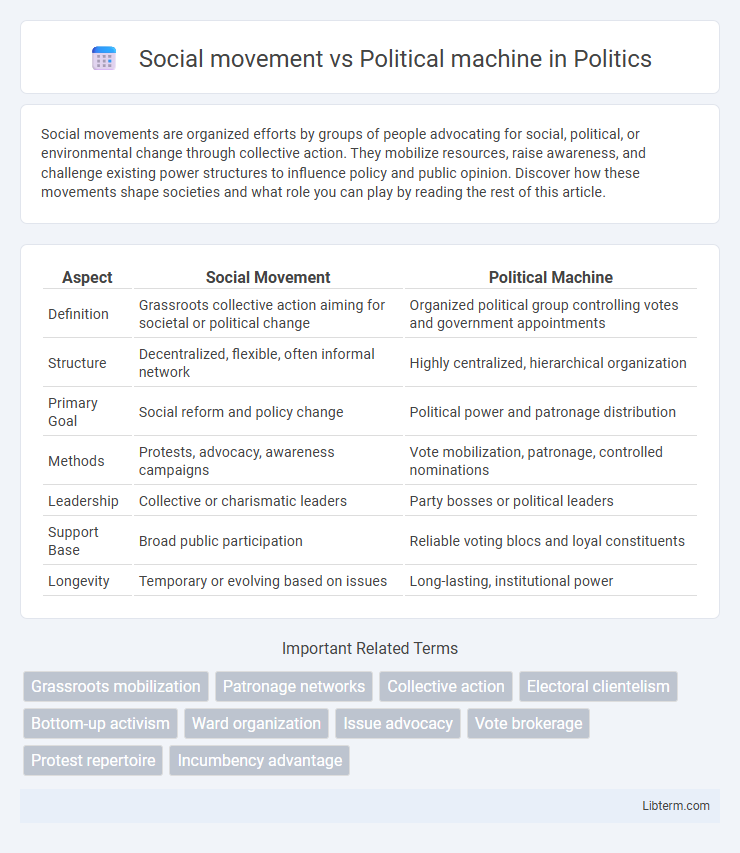Social movements are organized efforts by groups of people advocating for social, political, or environmental change through collective action. They mobilize resources, raise awareness, and challenge existing power structures to influence policy and public opinion. Discover how these movements shape societies and what role you can play by reading the rest of this article.
Table of Comparison
| Aspect | Social Movement | Political Machine |
|---|---|---|
| Definition | Grassroots collective action aiming for societal or political change | Organized political group controlling votes and government appointments |
| Structure | Decentralized, flexible, often informal network | Highly centralized, hierarchical organization |
| Primary Goal | Social reform and policy change | Political power and patronage distribution |
| Methods | Protests, advocacy, awareness campaigns | Vote mobilization, patronage, controlled nominations |
| Leadership | Collective or charismatic leaders | Party bosses or political leaders |
| Support Base | Broad public participation | Reliable voting blocs and loyal constituents |
| Longevity | Temporary or evolving based on issues | Long-lasting, institutional power |
Understanding Social Movements: Definitions and Characteristics
Social movements are organized collective efforts advocating for social change, driven by shared grievances and a common identity, whereas political machines are structured organizations designed to secure political power through patronage and loyalty. Key characteristics of social movements include grassroots mobilization, non-institutionalized actions, and emphasis on cultural or social transformation rather than immediate political control. Understanding these distinctions highlights how social movements prioritize broad societal impact over the electoral-focused strategies typical of political machines.
What Is a Political Machine? Key Features Explained
A political machine is an organized group that controls political activities and elections within a specific area through a hierarchical structure and patronage systems. Key features include centralized leadership, the exchange of favors or jobs for votes, and a focus on maintaining power rather than promoting broad social change. Unlike social movements, political machines prioritize short-term electoral victories and loyalty over ideological or reformist goals.
Historical Origins: Social Movements and Political Machines
Social movements historically emerged from grassroots efforts aimed at societal reform, with notable examples such as the Civil Rights Movement in the 1960s, originating from community activism and widespread public mobilization. Political machines, exemplified by Tammany Hall in 19th-century New York City, developed through organized party systems that controlled elections and patronage within urban politics. Both phenomena reflect distinct responses to political power dynamics, one rooted in collective advocacy and the other in structured political control.
Goals and Objectives: Change vs. Control
Social movements primarily aim to achieve social or political change by mobilizing public support around issues such as civil rights, environmental protection, or economic justice. Political machines, in contrast, focus on maintaining control over government resources and political power, often through patronage and organized voter mobilization to secure elections and influence policy decisions. While social movements seek transformation and advocacy for broader societal interests, political machines prioritize stability and dominance within the political system.
Leadership Structures: Grassroots vs. Hierarchical
Social movements typically feature grassroots leadership structures that encourage collective participation and decentralized decision-making, fostering organic growth and community involvement. Political machines operate with hierarchical leadership, centralized authority, and top-down control to efficiently mobilize votes and maintain political power. The contrast between these models highlights how social movements emphasize inclusiveness and adaptability, while political machines prioritize organization and discipline for electoral success.
Mobilization Strategies: Organizing People and Power
Social movements mobilize people through grassroots organizing, leveraging collective identity and shared goals to inspire voluntary participation and sustained activism. Political machines use hierarchical structures and patronage networks to consolidate power, relying on strategic incentives and controlled resources to secure loyalty and votes. Mobilization in social movements emphasizes empowerment and mass engagement, while political machines prioritize centralized coordination and material rewards.
Influence on Policy and Governance
Social movements mobilize public opinion and grassroots activism to pressure policymakers, often leading to policy changes that reflect collective demands and social justice goals. Political machines rely on organized networks, patronage, and electoral control to influence governance and secure loyalty, often prioritizing power consolidation over broad-based reforms. While social movements drive transformative policy shifts through civic engagement, political machines maintain control by managing political resources and voter blocs.
Case Studies: Famous Social Movements and Political Machines
The Civil Rights Movement, a landmark social movement, mobilized millions to challenge racial segregation and discrimination in the United States during the 1950s and 1960s, exemplifying grassroots activism and mass protests. In contrast, the Tammany Hall political machine dominated New York City politics in the 19th and early 20th centuries through patronage, vote-buying, and organizational control, securing loyalty and influence within immigrant communities. These case studies highlight how social movements rely on collective action for systemic change, while political machines maintain power through structured networks and transactional relationships.
Advantages and Drawbacks of Each Approach
Social movements mobilize grassroots support to drive social change, offering advantages like increased public engagement and adaptability, but face drawbacks such as limited resources and organizational instability. Political machines provide structured, long-term political influence through centralized control and resource distribution, ensuring consistent power but often fostering corruption and reducing democratic participation. Both approaches impact political dynamics differently, with social movements emphasizing reform and political machines prioritizing control.
The Evolving Relationship: Collaboration and Conflict
Social movements and political machines often exhibit a dynamic interplay marked by collaboration and conflict, shaping political landscapes over time. While social movements mobilize grassroots support to challenge existing power structures, political machines leverage organized networks and resources to maintain control and influence outcomes. This evolving relationship reflects fluctuating alliances where movements may co-opt machine strategies for reform, yet clash over autonomy and agendas.
Social movement Infographic

 libterm.com
libterm.com